Babe Ruth did it. Bobo Newsom did it four times. Joe McGinnity did it three times in a month. Two pitchers did it in the same ballpark on the same day. But nobody’s done it since 1973, and then it happened by accident.
“It” is starting both games of a major league doubleheader as a pitcher. And as I bring you a history of pitchers who have done it, let me thank Theodore Turocy, who generated a list of the pitchers involved using Retrosheeet’s game logs; all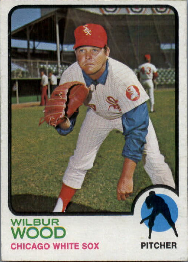 those who helped Retrosheet assemble the data in the first place; and the SABR folks behind The Baseball Index that allowed me to find some interesting reading.
those who helped Retrosheet assemble the data in the first place; and the SABR folks behind The Baseball Index that allowed me to find some interesting reading.
The last pitcher who did it was Wilbur Wood on July 20, 1973, at Yankee Stadium, and as I mentioned, it happened by accident. He started the first game and was pulled after the first six batters reached base; all of them eventually scored, and the Yankees went on to win 12-2. That ended an eight-game winning streak Wood had against the Yankees going back to 1971.
According to game story by Murray Chass in the next day’s New York Times, after Wood was hooked in game one, he asked manager Chuck Tanner in the dugout if Tanner wanted him to start game two. “Since he had thrown only 26 pitches…he volunteered to start the second game.”
“I discussed it with Johnny Sain [the pitching coach],” the manager related between games, “and the more we thought about it, the more we liked the idea. He’s my best pitcher and you like to have him out there whenever possible.”
Richard Dozer, writing in the Chicago Tribune, said Wood was booked on a 9 p.m. flight to his home in Boston; the All-Star break was coming up, and Wood had received permission to leave the team early because his seven-year-old son had recently undergone minor surgery. “But,” Dozer added, “Wood told Tanner he’d start the second game too, if his manager saw fit. Woody couldn’t believe his knuckle ball was that bad in the opener.”
Wilbur got a little more rest when rain delayed the start of the second game by 47 minutes. He retired the first nine batters he faced, but then the White Sox committed two errors in the fourth, leading to two unearned runs. He was knocked out in the fifth inning after Roy White hit a grand slam to give the Yankees a 7-0 lead that held up as the final score. On the day, Wood went 0-2 with a 20.77 ERA (and he allowed three UNearned runs).
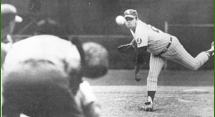
Wilbur Wood’s knucker in flight
At the end of that doubleheader Wood had started exactly one-third of the White Sox’ games that season, 32 of 96. Wood was a knuckeball pitcher who had been an incredibly durable relief pitcher, leading the American League in appearances three straight years (1968-70), averaging 80 games and 133 innings a season. Tanner took over as White Sox manager in September 1970, and the next year he made Wood a starting pitcher. Over the next five seasons Wood led the league in games started four times and in innings pitched twice, and during the first three of those seasons he finished in the top five in the Cy Young Award voting each year.
| Year | W | L | ERA | G | GS | CG | SHO | IP |
|---|---|---|---|---|---|---|---|---|
| 1971 | 22 | 13 | 1.91 | 44 | 42 | 22 | 7 | 334.0 |
| 1972 | 24 | 17 | 2.51 | 49 | 49 | 20 | 8 | 376.2 |
| 1973 | 24 | 20 | 3.46 | 49 | 48 | 21 | 4 | 359.1 |
| 1974 | 20 | 19 | 3.60 | 42 | 42 | 22 | 1 | 320.1 |
| 1975 | 16 | 20 | 4.11 | 43 | 43 | 14 | 2 | 291.1 |
Wood was on his way to a similar year in 1976, although by now Paul Richards was managing the team. Wood started seven of the team’s first 18 games, but took a line drive off his knee off the bat of Detroit’s Ron LeFlore in the seventh start. His kneecap shattered, he missed the rest of the season and was never the same pitcher.
Wood almost made his doubleheader debut in 1971, also at Yankee Stadium. In the first game of a doubleheader on July 18 he shut out the Yankees on four hits through eight innings, then the Yankees put together a three-run rally without the aid of an extra-base hit to score three runs in the ninth and win. He said after the game he wasn’t tired and could go right back in the second game, but Tanner went with Tom Bradley and the Yankees finished the sweep.
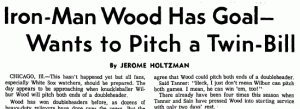 That incident led to an article beneath the headline at left in the August 7, 1971, issue of The Sporting News. Tanner was enthusiastic of using Wood to start both games of a double dip: “Heck, I just don’t mean Wilbur can pitch both games. I mean, he can win ’em, too!” Asked how he felt about the prospect, Wood said, “I’d love to try it.”
That incident led to an article beneath the headline at left in the August 7, 1971, issue of The Sporting News. Tanner was enthusiastic of using Wood to start both games of a double dip: “Heck, I just don’t mean Wilbur can pitch both games. I mean, he can win ’em, too!” Asked how he felt about the prospect, Wood said, “I’d love to try it.”
It all depends what kind of delivery you have in the first game. If you have a nice and easy delivery and don’t throw too many pitches, I don’t think it would be that tough to pitch the second game, too.
During his first three years as a starter, which were also his most successful ones (1971-73), Wood made 60 starts on less than three days rest. Tanner limited that practice after 1973, and Richards ended it in 1976. But in 1972 Wood made more starts on two days rest (25) than he did with longer rest (24). And pitching on two days rest he was 12-10 with a 2.62 ERA. Notice his 376-2/3 innings pitched that season, which came before the designated hitter rule that eliminated the need to ever remove a pitcher for a pinch-hitter. It was the most innings pitched in a season since Pete Alexander threw 388 in 1917 (although Mickey Lolich had thrown 376 just the year before).
While starting both games of a doubleheader gets attention, Wood actually had a more impressive endurance feat earlier in the 1973 season, in what the Chicago Tribune’s Richard Dozer called “one of the most fascinating achievements of modern times.”
On May 26 at Comiskey Park, the game between the White Sox and Indians was suspended due to curfew after 16 innings. The next day’s scheduled game was rained out, so the suspended game was resumed on May 28, Memorial Day, before the scheduled game. Wood was scheduled to start the scheduled game, so, in a move that was not terribly unusual, Tanner chose him to pitch when the suspended game was resumed. Likewise, Cleveland manager Ken Aspromonte named the man who he was planning to start in the scheduled game, Milt Wilcox, to take the mound when the suspended game resumed. (In the game on the 26th, starting pitchers Stan Bahnsen and Gaylord Perry each went 13 innings, facing 48 and 52 batters, respectively.)
The suspended game went on for a while as neither team could score. Wood went five innings, 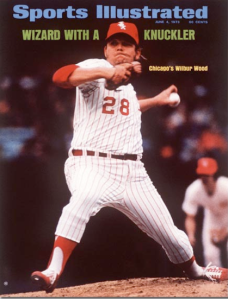 facing 18 batters, and gave up an unearned run in the top of the 21st. But he got the victory when Dick Allen hit a two-run homer (off future Chisox broadcaster Ed Farmer) in the bottom of the inning. (Allen played the last eight innings of the game at second base, without making an error, after Tanner pinch-ran for starter Jorge Orta and pinch-hit for replacement Luis Alvarado. It was the longest of Allen’s four appearances at second base in the majors.)
facing 18 batters, and gave up an unearned run in the top of the 21st. But he got the victory when Dick Allen hit a two-run homer (off future Chisox broadcaster Ed Farmer) in the bottom of the inning. (Allen played the last eight innings of the game at second base, without making an error, after Tanner pinch-ran for starter Jorge Orta and pinch-hit for replacement Luis Alvarado. It was the longest of Allen’s four appearances at second base in the majors.)
The White Sox took a shorter-than-normal 15-minute break between the end of the suspended game and the start of the scheduled game, so that Wood wouldn’t get too cooled off. As it was he went 23 minutes between appearances on the mound, but afterward he said, “It was just like a long inning between trips to the mound.” (Wilcox pitched 4-1/3 innings before being relieved in the suspended game, and Aspromonte had second thoughts about starting him in the scheduled game, turning to Dick Tidrow instead.)
In a fast-paced game that ended in fog, Wood pitched a four-hit shutout. So Wood earned two victories and pitched 14 innings (without allowing an earned run) on the day…but the five innings of his appearance in the suspended game show up in the records as if they happened on May 26, when the game started. (Wood never pitched more than 13 innings in a single game in his career, but he had won two games in a day before, winning both games of a doubleheader at Seattle against the Pilots on June 24, 1969. He went 3-2/3 innings in the first game, 2 innings in the nightcap, and didn’t allow a run in either.)
“Wood…confessed he would be stiff in the shoulder today,” Dozer wrote in the next morning’s Chicago Tribune, “but insisted he never tired.”
The two Memorial Day wins pushed Wood’s 1973 record to 13-3, and he was 27 days ahead of the pace of Denny McLain on his way to 31 wins in 1968. “I call him Wilbur Wonderful,” Tanner told reporters after Wood’s marathon. His catcher Ed Herrmann said, “He’ll have kids all over the country throwing knuckleballs pretty soon.”
As it happened, Wood’s Memorial Day marathon came the week he appeared on the cover of Sports Illustrated…which, like his starting both games of a doubleheader, was an accident. In fact, it led to “Wilbur Wood” becoming a frequently-used term at the magazine. Here’s how Robert L. Miller described it in his “Letter From The Publisher” in the April 22, 1985 issue:
Wilbur’s name caught on in 1973, when rain delayed the Indianapolis 500 past our final deadline and we went to press with a Wood cover and story that had already been put to bed for just that eventuality. Thus was born an institution. Thereafter, whenever we have approached a major event that for one reason or another might be aborted at the last moment, we have prepared a “Wilbur Wood” that could take the place of the canceled story.
The last pitcher to have started both games of a doubleheader before Wood really shouldn’t count. On May 26, 1971, San Diego manager Preston Gomez named righthander Al Santorini as his starter in the first game of a twin-bill against Houston. But after Santorini retired leadoff hitter Roger Metzger, Gomez yanked him for lefty Dave Roberts, who then went the rest of the way in a game the Astros won 2-1. Houston manager Harry Walker had started left-handed hitters Rich Chiles, Norm Miller and Johnny Edwards against Santorini, but pulled them all after Roberts entered. Santorini then started the second game and pitched six innings, taking the loss.
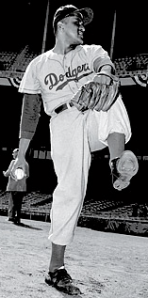
Don Newcombe
The last time a starting pitcher had substantial work in both games of a doubleheader was a remarkable performance by Brooklyn’s Don Newcombe on September 6, 1950. The Dodgers swept a doubleheader at Philadelphia, although Newcombe did not get credit for the win in the second game. According to Joe King’s story in The Sporting News, Newcombe and Dodger manager Burt Shotton had talked about the prospect of his pitching both games of the twin bill on the train down to Philadelphia, with the Dodgers entering the series 7-1/2 games behind the Phils. King wrote that Shotton told Newcombe, “You can do two if you pitch a shutout in the opener.” Newk blanked the Phillies on three hits in the first game, which lasted just 2 hours 15 minutes, and he got the green light to keep going. “I figured he was hot right then and ought to try again,” Shotton said, according to King. Newcombe allowed just two runs over seven innings in the nightcap — giving him 16 innings pitched on the day — but was trailing 2-0 when he was lifted for a pinch-hitter in the eighth. The Dodgers then rallied with three runs in the ninth to win.
For what it’s worth, Roscoe McGowen’s story about the Dodgers’ sweep that appeared in the next day’s New York Times really doesn’t make any kind of a big deal about Newcombe’s feat, which I find strange.
Newcombe was the second pitcher to start both games of a doubleheader in 1950, but the first one, like Santorini in 1971, was a fluke. On May 20, the Giants hosted Cincinnati at the Polo Grounds. Here’s the way the story was told in the May 31 issue of The Sporting News:
The over-emphasized theory of a lefthanded hitter’s advantage against a righthanded pitcher reached the silly stage, May 20, when Leo Durocher of the Giants and Luke Sewell of the Reds both warmed up two pitchers for the first game of a double-header. The Giants were trying to match Dave Koslo against Ewell Blackwell, because Dave bats from the south side. The Reds, attempting to thwart Leo, had Portsider Ken Raffensberger ready.
When the game started with Monte Kennedy, a righthanded swatter, against Blackwell, Durocher yanked him after he retired the first batter, Koslo then pitching a two-hit shutout in the most unusual ‘relief’ win of the year. Dave, incidentally, failed to hit and fanned twice. And Kennedy, who pitched the nightcap against Raffensberger, also failed to hit.
So according to this account, Durocher went through this so that Koslo — who never hit more than .145 in a season in the majors — could have the platoon advantage as a hitter? Wow. Kennedy went the distance in the second game as the Giants won, 4-3.
The king of the doubleheader pitchers in the “lively ball” era was Bobo Newsom, who as mentioned did it four times in a career that saw him win 211 major league games. The first time was when he was a 26-year-old rookie with the St. Louis Browns in 1934. On September 14 at Sportsman’s Park, Newsom walked the first four Philadelphia hitters and was yanked by manager Rogers Hornsby. But Hornsby started Newsom again in the nightcap, and this time Bobo struck out the first four batters. He went the distance in a 5-2 Browns victory for his 15th win of the season (he would finish at 16-20).
Newsom was acquired by the Red Sox midway through the 1937 season. On September 27, he pitched a complete game in the opener of a Fenway Park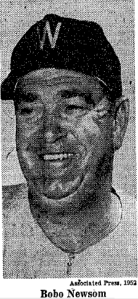 doubleheader against the Athletics, with the Bosox winning 6-2. He started again in the second game but was wild and was knocked out in the third inning of a game the A’s won, 6-0.
doubleheader against the Athletics, with the Bosox winning 6-2. He started again in the second game but was wild and was knocked out in the third inning of a game the A’s won, 6-0.
Bobo was back with the Browns, on his way to his first 20-win season, in 1938 when he tried for another double victory. On August 7, pitching at home, he got a complete game 5-3 win over–yet again–Philadelphia in the opener, then started again in the second game. But he weakened and was pulled in the fourth, taking the loss.
Newsom’s last double dip was as a 37-year-old in 1945, this time pitching for the A’s. On August 21 he started both games against the Tigers in Detroit after boasting beforehand that he would go all the way and win both games. But he won neither. He left in the seventh inning of the opener with a three-run lead; the Tigers came back to tie, but the A’s won in 11. Then in the second game, Bobo was staked to a 4-0 lead in the top of the first but couldn’t hang on; he pitched into the ninth but took the loss when Rudy York got the game-winning hit off reliever Joe Berry.
Ken Heintzelman was the starting pitcher in both games for the Pirates in their doubleheader sweep of the Giants at Forbes Field on August 3, 1941, but he got the win in neither game. In fact, he was hit hard in both games and was trailing when he left, going just two-thirds of an inning in the opener and 1-1/3 in the second game. The fact that Heintzelman was brought back to start the second game did not merit any special attention in the New York Times game story.
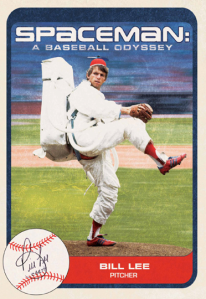
This Bill Lee never started both games of a doubleheader
Big Bill Lee (not to be confused with the Spaceman) started both games of a 1937 doubleheader for the Cubs and didn’t even merit a mention in the AP game account that appeared in the New York Times. He was knocked out in the third inning of the opener, a game the Cubs rallied to win in 14 against the Cardinals at Wrigley Field. He started again in the second game and pitched into the seventh, getting the win. Irving Vaughan’s reference to Lee’s feat in the Chicago Tribune was brief: “Undaunted by the blistering that chased him out of the first game, Lee returned as starter in the second.”
Elon “Chief” Hogsett had a disastrous day for the Browns in a doubleheader against the Tigers on August 18, 1936, in St. Louis. He started both games and got only one out in each, giving up a total of 10 hits. (The Browns rallied to win game one.) Hogsett had spent six seasons with the Tigers before they traded him to the Browns in April 1936.
Jack Russell started both games of a doubleheader for the Red Sox at Fenway Park on September 10, 1929, and lost them both. In the opener he got the hook after the Browns scored four runs in the top of the first. The second game went much better, as Russell went the distance and allowed just six hits, but the Browns won 1-0. Russell was the last pitcher to start and lose both games of a doubleheader until Wood did it in 1973. An item in the New York Times on July 22, 1973, quoted Seymour Siwoff of the Elias Sports Bureau as saying that had not been done since Fred Toney did it for Cincinnati in 1918.
On September 14, 1928, Bob Smith started the opener for the Braves against the Giants and was relieved after giving up singles to each of the game’s first four batters. He took the loss in that game, then started the second and pitched into the seventh inning but took the loss in that one as well.
Jack Scott was the last pitcher to throw a complete game in both ends of a doubleheader. It happened in Cincinnati on June 19, 1927, with Scott pitching for the visiting Phillies. He pitched a six-hitter in the first game, with the Phils winning 3-1, then lost the second game, 3-0.
This takes us back to the last pitcher to start and win both games of a doubleheader: Emil “Dutch” Levsen, a 28-year-old righthander who took the hill twice for Cleveland on August 28, 1926 in Boston. The Indians won the opener, 6-1,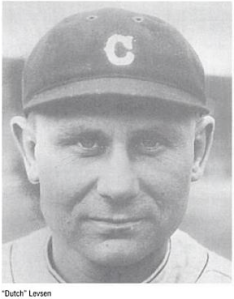 in a game that lasted just one hour and 29 minutes, then took the second game 5-1 in an hour and 40 minutes. Levsen allowed just four hits in each game and walked a total of three. The AP game story in the New York Times said, “He was going as strong at the finish [of the doubleheader] as at the start.” Levsen is also the last pitcher to hurl two nine-inning complete games in a day.
in a game that lasted just one hour and 29 minutes, then took the second game 5-1 in an hour and 40 minutes. Levsen allowed just four hits in each game and walked a total of three. The AP game story in the New York Times said, “He was going as strong at the finish [of the doubleheader] as at the start.” Levsen is also the last pitcher to hurl two nine-inning complete games in a day.
There’s a story about Levsen’s feat in the August 1955 Baseball Digest (“Last ‘Iron-Man’ Recalls Feat”) by Pat Harmon that originally appeared in the Cincinnati Post. According to that account, Levsen volunteered to pitch the second game after the first game went so smoothly, telling manager Tris Speaker, “My arm feels fine.” Here’s the tale as Russell Schneider tells it (without listing a source) in The Cleveland Indians Encyclopedia:
After the opener, Levsen was kidded by teammates about how easily he beat the Red Sox. Thus motivated, Levsen went to manager Tris Speaker and asked if he could also start the second game. Because the Indians’ pitching staff had been badly overworked, Speaker agreed, and Levsen practically duplicated his victory in the nightcap.
Levsen’s photo appeared on the cover of the September 9, 1926, issue of The Sporting News, under the headline “Echoes Of An Earlier Day.” Even then, as has always been the case through time, the “modern” player was considered wimpier than the heroes of yesteryear. The author wrote:
Shades of Joe McGinnity, Lou Durham, Ed Reulbach and others of an earlier, and as the old ‘line’ fans would have us believe, more robust period in baseball. . . . [Levsen’s] performance also gave lie to the current impression that all of our major league pitchers are powder-puff lads whose high earning arms are too puny to do a two-game trick without straining their gizzards, or something.
Levsen was a rookie in 1926, having had just brief cups of coffee with the Indians in each of the previous three seasons. He went 16-13, including the doubleheader wins, but would earn just three more wins in his major league career and would be done after July 1928. Schneider’s book mentions Levsen came up with arm trouble during spring training in 1927. [ADDED 11/21/18: Much more of Levsen’s story is now in the SABR BioProject, told by Chris Rainey.]
The year before Levsen’s feat, 1925, is the first year in which we don’t have record of a pitcher starting both games of a doubleheader since 1911, which in turn was the first such season since 1902.
Urban Shocker posted two complete-game wins for the Browns in a doubleheader at Chicago on September 6, 1924. The score of each game was 6-2, with Shocker allowing nine hits in the first game and only five in the nightcap.
Going back before that, I’ll just mention a few highlights…
The last National League pitcher to win two complete games in a doubleheader was Herman “Hi” Bell of the Cardinals on July 19, 1924, at St. Louis against the Braves. He threw a two-hitter in the first game, which lasted just one hour and 31 minutes, then came back to take the second game with a four-hitter than took just an hour and 14 minutes. Bell was a rookie who had won just one major league game before the doubleheader, and he wouldn’t win another game that season.
On August 12, 1921, both teams used the same starting pitcher in both games of a doubleheader at Braves Field in Boston, the only time that’s happened in major league history. Phillies manager Kaiser Wilhelm (who had taken over from Bill Donovan less than three weeks earlier) sent George Smith to the mound in both games, while boston skipper Fred Mitchell called on Jack Scott, the same fellow who threw the two complete games in a 1927 twin-bill. (Scott had also started both games of a double dip in 1920.) The account in the New York Times doesn’t call any special attention to the situation: “Scott and Smith started both games, but the former was hit hard and finished neither, and Smith did not finish the first.” Scott took the loss in both games; neither pitcher made it our of the third inning of the opener, then Smith threw a 12-hit shutout in game two.
The next day, Mitchell started Mule Watson in both games of another doubleheader against Philly, and Watson went the distance in winning both games, holding on to win the first game 4-3, then retiring the first 14 batters he faced in game two on the way to a two-hit shutout. Watson, like Scott, had previous experience starting two games in a day, having done so twice in his first two months in the majors in 1918 for the A’s. That made Watson, who won 50 games in an otherwise unremarkable major league career, the last man to do doubleheader duty twice in a season.
The “golden age” of doubleheader starters was from 1916 through 1918, with nine such cases in 1916, ten in 1917 (the most of any season ever) and six in 1918. During that time Hall of Famer Grover Cleveland Alexander did it twice for the Phillies, on September 23, 1916, against the Reds, and on September 3, 1917, against Brooklyn. (In both cases Ol’ Pete posted a pair of complete-game victories, making him one of only two men to get two complete-game wins in a day more than once. You’ll read about the other man later on.) On that latter date, two other pitchers also started both games of a double dip: Red Faber for the White Sox against the Tigers, and Phil Douglas, for the Cubs against the Cardinals. Coincidentally, it was Labor Day.
Christy Mathewson (who never started both games of a doubleheader in his Hall of Fame pitching career) gained one distinction in his only full season as a manager, in 1917 with the Reds: he was the only pilot ever to have three different pitchers start both games of a doubleheader in a season. He used rookie Hod Eller that way on June 19, Fred Toney on July 1, and Pete Schneider on September 26. Toney had the most success, going the distance in both games against the Pirates in Cincinnati and allowing only three hits in each (all singles), winning 4-1 and 5-1. That remains the fewest total hits ever allowed by a pitcher who started and won both ends of a doubleheader. Those games were the second and third games in the five-game career of Honus Wagner as a major league manager. The 43-year-old Wagner was in his final season as a player; he played first base and batted cleanup for his Pirates in both games, getting one hit in each.
Poor Pete Schneider had miserable luck, with the Reds being shut out in both his games against the Braves at Cincinnati. He lost the opener, 1-0, being lifted for a pinch-hitter after throwing eight innings, then went the distance in the second game and lost 3-0.
Toney is best remembered for his double no-hitter with Hippo Vaughn, also in 1917. And both men started both games in a doubleheader twice in their career. Toney also did it in 1918 for the Reds, while Vaughn did it in 1917 and 1920 for the Cubs.
Babe Ruth started both games of a doubleheader for the Red Sox against Chicago on July 11, 1916 at Boston, but the situation was similar to Al Santorini’s in 1971, James Cruisinberry described it in the Chicago Tribune:
There was some fancy jockeying of pitchers by both managers at the start of the first game. [Boston manager Bill] Carrigan announced Ruth, [Chicago manager Pants] Rowland announced [Dave] Danforth, both southpaws. After Ruth had pitched to one batter, he was removed and [Rube] Foster drawn out from behind the fence or some other secluded place. Rowland got even with Carrigan by letting Danforth pitch to one batter, and then yanking and providing Jim Scott. [Both relief pitchers were right-handed.] We haven’t been able yet to know what all that fancy brain stuff was about, but suspect there was some deep seated motive in the mind of each leader.
The Red Sox swept the doubleheader; they won the opener 5-3, then Ruth went the distance in a 3-1 Boston victory in the second game. That was one of his 23 wins on the season, just two fewer than league leader Walter Johnson. Thirty-five-year-old future Hall of Famer Ed Walsh finished the first game on the mound for Chicago in what would be his final appearance in a White Sox uniform. (Walsh will be back later in this discussion.)
The most distinguished doubleheader pitching achievement was that of “Big Ed” Reulbach of the Cubs, who did it only once, but nobody did it better. His big day was September 26, 1908, when he threw a pair of shutouts in Brooklyn, allowing a total of just eight hits. This was just three days after the famous “Merkle game” against the Giants. Charles Dryden covered Reulbach’s feat for the Chicago Tribune:
The grace, style, endurance and speed of Mr. Reulbach fits into this remarkable baseball race. He put the locals away so easily in the curtain raiser that [Cubs manager Frank] Chance granted his request to go in and bring them in again….Naturally, Mr. Reulbach is proud of his performance, and he will pitch all the rest of the games this season if the Peerless Leader [Chance] wants him to. The big champ was even better in the second go and his sped fairly blinded the dizzy young men of this town.
Reulbach did not pitch the rest of the Cubs’ games; in fact, he got four days rest before his next start, in which he shut out Cincinnati (his fourth straight shutout), then came back on one day’s rest to beat the Reds again for his 24th and final win of the season. The Cubs won six of their seven games after Reulbach’s doubleheader, including a replay of the “Merkle game,” to win the pennant.
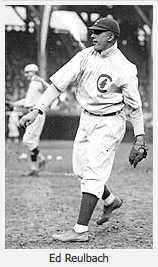 In her book about the 1908 season, “Crazy ‘08,” Cait Murphy wrote that Reulbach’s double shutout gave him the opportunity to take part of the 1908 equivalent of going on television with Ed Sullivan or Letterman: “The feat wins him an invitation to go on vaudeville after the season to deliver a monologue on his great performance. (He demurs, saying he would rather go fishing.)”
In her book about the 1908 season, “Crazy ‘08,” Cait Murphy wrote that Reulbach’s double shutout gave him the opportunity to take part of the 1908 equivalent of going on television with Ed Sullivan or Letterman: “The feat wins him an invitation to go on vaudeville after the season to deliver a monologue on his great performance. (He demurs, saying he would rather go fishing.)”
Oh, my favorite line in Dryden’s account of Reulbach’s twin wins: “In the second combat Reulbach grabbed the whitewash brush again and blanked the Superbas [as the Brooklyn team was then known] a second time in a corking good game.”
The day before Reulbach’s feat there was another unique achievement in the history of doubleheader pitchers. Detroit’s rookie righthander Ed Summers remains the only man to pitch a pair of complete-game victories and throw more than 18 innings. He held the Athletics to six hits in the first game, and the Tigers rallied for five runs in the bottom of the eighth to post a 7-2 win. Then the nightcap went into extra innings a scoreless tie before Detroit’s Claude Rossman homered leading off the bottom of the tenth, Summers finishing with a two-hit shutout.
Three days after Reulbach’s twin whitewashes, another “Big Ed,” Ed Walsh of the crosstown White Sox, won both ends of a doubleheader with a pair of complete games, defeating Boston 5-1 and 2-0. “Walsh is no iron man,” according to the next day’s Chicago Tribune. “He is made of steel.” In fact, the game story began, “Eddie Walsh, the man of steel…” (This, 30 years before Superman.) Later in the game story: “Walsh was greeted with a great roar of applause from the chilled crowd when he went back for the second game after a five-minute rest.”
The double wins were part of a remarkable stretch drive for Walsh as the White Sox tried (and failed) to pull out the pennant. Three days later, Walsh struck out 15 against Cleveland but lost, 1-0, when Addie Joss pitched a perfect game. The next day he came on in relief to get a save, then after taking a day off he pitched a complete game, then the next day pitched 3-2/3 innings of relief. Walsh won 40 games in 1908 and pitched 464 innings, which is still a post-1900 record.
The Baseball Almanac web site has a list of pitchers who earned two complete game victories in one day, and that list also credits Walsh with such an achievement on September 26, 1905. But while Walsh did pitch nine innings in the first game, it was not a complete game. Doc White (who himself had started both games of a doubleheader in 1904) started the opener, but after giving up a leadoff single “could not get them over for [the next batter, Jake] Stahl because his arm hurt,” according to the Tribune. Walsh came in without having had a chance to warm up, and the Red Sox wound up scoring five runs before the side was retired, two of them on bases-loaded walks. But the White Sox rallied to win that game and took the nightcap (which was called after eight innings on account of darkness), as Walsh allowed just one run in his last 16 innings of work on the day.
Jock Menefee started both ends of a doubleheader for Chicago against Pittsburgh on September 7, 1903, and did not get the decision in either game. This normally wouldn’t merit mention, but it turned out to be the last major league appearances for the 35-year-old righthander, making him the only player ever to end his big league career this way.
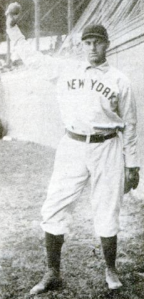
Joe McGinnity
We’ve now gone back to the most reknowned of all doubleheader pitching feats: that of Joe McGinnity, who earned complete game victories in both games of a twin bill THREE TIMES IN ONE MONTH, August 1903. Known as “Iron Man” (because of his offseason work at his wife’s family’s iron foundry in Oklahoma), McGinnity completed 44 of 48 starts that season and hurled a career-high 434 innings. He had also started both games of a doubleheader twice in 1901, just nine days apart. But his 1903 feat remains unmatched.
It started August 1 in Boston, when McGinnity’s Giants won by scores of 4-1 and 5-2. The account in the New York Times said, “McGinnity requested [manager John] McGraw to permit him to pitch both games, and his work was a revelation to the large crowd.” One week later, on August 8 at the Polo Grounds, McGinnity bested Brooklyn, 6-1 and 4-3. (McGinnity was lifted for a pinch-hitter in the bottom of the ninth in the second game but pinch-hitter George Van Haltren drove in the winning run.) McGinnity’s pitching wasn’t all he did that was worthy of mention that day. From the New York Times game account:
During the second game more than half of the Brooklyn team left their fielding positions and gathered around Umpire “Tim” Hurst to protest his allowing McGinnity to take third base after being interfered with when he stole to [sic] second. McGinnity stood on third rubbing a supposedly bruised leg, while the players argued with the umpire. They were so absorbed in the dispute that Schmidt, the pitcher, walked away from his box and left the ball lying almose [sic] in the middle of the diamond. McGinnity, cleverly coached by McGraw, took advantage of this opportunity and stole home. The Brooklyn players looked sheepishly at each other, and then protested more vigorously, while the crowd cheered derisively.
By the way, Hurst was the only umpire working the doubleheader. McGinnity stole 26 bases over ten major league seasons from 1899 through 1908.
On August 31 at the Polo Grounds, McGinnity did it again, beating Philadelphia 4-1 and 9-2. “At the end McGinnity showed no sign of fatigue,” according to the Times. “In fact, he seemed fresh enough to tackle the visitors for a third contest of that were necessary.”
(P.S. I’m not going to even attempt to chronicle pitchers who have started both games of a doubleheader in the minor league, but here is a great piece about Eddie Locke, who pitched complete games in both ends of a twin bill FOUR TIMES for Amarillo of the West Texas-New Mexico League in 1953.)
Here, thanks to Theodore Turocy, is a list of all the instances of a pitcher starting both games of a doubleheader since 1901.
| Date | Pitcher | Team | Opponent | Lg |
| 9/3/1901 | Joe McGinnity | Baltimore | Milwaukee | AL |
| 9/12/1901 | Joe McGinnity | Baltimore | Philadelphia | AL |
| 6/25/1903 | Wiley Piatt | Boston | St. Louis | NL |
| 8/1/1903 | Joe McGinnity | New York | Boston | NL |
| 8/8/1903 | Joe McGinnity | New York | Brooklyn | NL |
| 8/21/1903 | Rube Waddell | Philadelphia | Detroit | AL |
| 8/31/1903 | Joe McGinnity | New York | Philadelphia | NL |
| 9/7/1903 | Jock Menefee | Chicago | Pittsburgh | NL |
| 9/11/04 | Kid Nichols | St. Louis | Cincinnati | NL |
| 9/24/04 | Jack Taylor | St. Louis | Philadelphia | NL |
| 10/2/04 | Doc White | Chicago | New York | AL |
| 10/8/04 | George Mullin | Detroit | Cleveland | AL |
| 6/28/05 | Jack Chesbro | New York | Boston | AL |
| 7/1/05 | Frank Owen | Chicago | St. Louis | AL |
| 7/4/05 | Orval Overall | Cincinnati | Pittsburgh | NL |
| 10/3/05 | Doc Scanlan | Brooklyn | St. Louis | NL |
| 8/13/06 | Rube Waddell | Philadelphia | St. Louis | AL |
| 9/22/06 | George Mullin | Detroit | Washington | AL |
| 6/3/07 | Stoney McGlynn | St. Louis | Cincinnati | NL |
| 7/14/07 | Frank Smith | Chicago | Washington | AL |
| 7/31/07 | Irv Young | Boston | Pittsburgh | NL |
| 9/14/07 | Ed Siever | Detroit | St. Louis | AL |
| 7/7/08 | Bill Burns | Washington | Chicago | AL |
| 8/11/08 | Rube Vickers | Philadelphia | Cleveland | AL |
| 9/25/08 | Ed Summers | Detroit | Philadelphia | AL |
| 9/26/08 | Ed Reulbach | Chicago | Brooklyn | NL |
| 9/29/08 | Ed Walsh | Chicago | Boston | AL |
| 6/21/09 | Tom Hughes | Washington | New York | AL |
| 9/29/09 | Ed Killian | Detroit | Boston | AL |
| 6/21/10 | Irv Young | Chicago | Cleveland | AL |
| 7/4/10 | Bob Harmon | St. Louis | Cincinnati | NL |
| 8/16/10 | Sam Frock | Boston | St. Louis | NL |
| 8/20/12 | Vean Gregg | Cleveland | Washington | AL |
| 7/19/13 | Boardwalk Brown | Philadelphia | Chicago | AL |
| 9/10/14 | Harry Billiard | Indianapolis | Baltimore | FL |
| 9/22/14 | Ray Collins | Boston | Detroit | AL |
| 9/26/14 | Bill Bailey | Baltimore | St. Louis | FL |
| 5/31/15 | Reb Russell | Chicago | Detroit | AL |
| 7/18/15 | Cy Falkenberg | Newark | Kansas City | FL |
| 7/22/15 | Pete Schneider | Cincinnati | Philadelphia | NL |
| 7/31/15 | Dave Davenport | St. Louis | Buffalo | FL |
| 8/3/15 | Happy Finneran | Brooklyn | Pittsburgh | FL |
| 8/27/15 | George Pierce | Chicago | Boston | NL |
| 9/18/15 | Doc Watson | St. Louis | Brooklyn | FL |
| 7/11/16 | Babe Ruth | Boston | Chicago | AL |
| 7/29/16 | Dave Davenport | St. Louis | New York | AL |
| 8/17/16 | Hooks Dauss | Detroit | Washington | AL |
| 8/29/16 | Lefty Tyler | Boston | Pittsburgh | NL |
| 9/6/16 | Rube Benton | New York | Brooklyn | NL |
| 9/9/16 | Pol Perritt | New York | Philadelphia | NL |
| 9/12/16 | Dick Rudolph | Boston | Chicago | NL |
| 9/20/16 | Al Demaree | Philadelphia | Pittsburgh | NL |
| 9/23/16 | Pete Alexander | Philadelphia | Cincinnati | NL |
| 6/19/17 | Hod Eller | Cincinnati | Chicago | NL |
| 6/23/17 | Ray Caldwell | New York | Philadelphia | AL |
| 7/1/17 | Fred Toney | Cincinnati | Pittsburgh | NL |
| 9/3/17 | Pete Alexander | Philadelphia | Brooklyn | NL |
| 9/3/17 | Red Faber | Chicago | Detroit | AL |
| 9/3/17 | Phil Douglas | Chicago | St. Louis | NL |
| 9/11/17 | Hippo Vaughn | Chicago | Cincinnati | NL |
| 9/18/17 | Bill Doak | St. Louis | Brooklyn | NL |
| 9/19/17 | Elmer Jacobs | Pittsburgh | Boston | NL |
| 9/26/17 | Pete Schneider | Cincinnati | Boston | NL |
| 6/23/18 | Fred Toney | Cincinnati | Pittsburgh | NL |
| 7/2/18 | Lee Meadows | St. Louis | Chicago | NL |
| 7/21/18 | Mule Watson | Philadelphia | Cleveland | AL |
| 7/26/18 | Dolf Luque | Cincinnati | Boston | NL |
| 8/30/18 | Carl Mays | Boston | Philadelphia | AL |
| 8/31/18 | Mule Watson | Philadelphia | Boston | AL |
| 6/28/19 | Carl Mays | Boston | New York | AL |
| 8/16/19 | Eppa Rixey | Philadelphia | Pittsburgh | NL |
| 9/27/19 | Allen Russell | Boston | Washington | AL |
| 7/5/20 | Jack Scott | Boston | Brooklyn | NL |
| 7/28/20 | Hippo Vaughn | Chicago | Boston | NL |
| 9/18/20 | Ferdie Schupp | St. Louis | Boston | NL |
| 8/12/21 | George Smith | Philadelphia | Boston | NL |
| 8/12/21 | Jack Scott | Boston | Philadelphia | NL |
| 8/13/21 | Mule Watson | Boston | Philadelphia | NL |
| 9/6/21 | Bill Bailey | St. Louis | Chicago | NL |
| 9/24/21 | Dixie Davis | St. Louis | Boston | AL |
| 7/25/22 | Guy Morton | Cleveland | Philadelphia | AL |
| 9/18/22 | Johnny Morrison | Pittsburgh | Philadelphia | NL |
| 7/10/23 | Johnny Stuart | St. Louis | Boston | NL |
| 7/17/23 | Dolf Luque | Cincinnati | Boston | NL |
| 8/11/23 | George Mogridge | Washington | Chicago | AL |
| 7/19/24 | Hi Bell | St. Louis | Boston | NL |
| 8/16/24 | Eddie Rommel | Philadelphia | Cleveland | AL |
| 9/6/24 | Urban Shocker | St. Louis | Chicago | AL |
| 8/28/26 | Dutch Levsen | Cleveland | Boston | AL |
| 6/19/27 | Jack Scott | Philadelphia | Cincinnati | NL |
| 9/14/28 | Bob Smith | Boston | New York | NL |
| 9/10/29 | Jack Rusell | Boston | St. Louis | AL |
| 9/14/34 | Bobo Newsom | St. Louis | Philadelphia | AL |
| 8/18/36 | Elon Hogsett | St. Louis | Detroit | AL |
| 7/5/37 | Bill Lee | Chicago | St. Louis | NL |
| 9/27/37 | Bobo Newsom | Boston | Philadelphia | AL |
| 8/7/38 | Bobo Newsom | St. Louis | Philadelphia | AL |
| 8/3/41 | Ken Heintzelman | Pittsburgh | New York | NL |
| 8/21/45 | Bobo Newsom | Philadelphia | Detroit | AL |
| 5/20/50 | Monte Kennedy | New York | Cincinnati | NL |
| 9/6/50 | Don Newcombe | Brooklyn | Philadelphia | NL |
| 5/26/71 | Al Santorini | San Diego | Houston | NL |
| 7/20/73 | Wilbur Wood | Chicago | New York | AL |
These are the pitchers who started both games of a doubleheader more than once, along with the years in which they did so:
| Joe McGinnity | 5 | 1901 (2), 1903 (3) |
| Bobo Newsom | 4 | 1934, 1937, 1938, 1945 |
| Jack Scott | 3 | 1920, 1921, 1927 |
| Mule Watson | 3 | 1918 (2), 1921 |
| Pete Alexander | 2 | 1916, 1917 |
| Dave Davenport | 2 | 1915, 1916 |
| Dolf Luque | 2 | 1918, 1923 |
| Carl Mays | 2 | 1918, 1919 |
| George Mullin | 2 | 1904, 1906 |
| Pete Schneider | 2 | 1915, 1917 |
| Fred Toney | 2 | 1917, 1918 |
| Hippo Vaughn | 2 | 1917, 1920 |
| Rube Waddell | 2 | 1903, 1906 |
| Irv Young | 2 | 1907, 1910 |
Pingback: Updating some earlier items « The J.G. Preston Experience
Pingback: More about pitchers who have started both games of a doubleheader « The J.G. Preston Experience
Absolutely fantastic article on Wilbur Wood,thank you so much for writing this! And to think they make a big deal out of a pitcher having to work on 3 days rest nowadays!!!! I play a basebakk simulation game with cards and dice (now I play the PC version) and am replaying the entire 71′ season.I just played a game in which Wood shutout the mighty A’s 1-0. Aagin,fantastic and thanks!
Pingback: A bit about Salt Lake City’s Bonneville Park in the 1920s « The J.G. Preston Experience
To J G Preston, Another comment 3+ years after the last comment posted. I copied your article. I have a co-worker that was from Philadelphia and went to about 5 MLB games in his life as a kid. Not much of a baseball fan but he talked about being at Shibe Park the day Don Newcombe of Brooklyn started both games of a doubleheader against the Phillies.He knew it was around 1949-50 and told me the games were late in the season. I researched the games and realized he was talking about Sept 6, 1950. Newk pitched nine innings in the first game to get a shutout victory. In the second game he pitched seven complete innings and left down 2-0. Brooklyn rallied in the ninth to win the second game too. Anyway, he asked me how many other pitchers did the same thing- starting both ends of a doubleheader. That curiosity brought me to your website. Thanks.
Thank you, Tom. This post still gets pretty regular traffic as there always seems to be people curious about the subject. And the good news is, I don’t think I’ll ever have to update it because I can’t imagine it will ever happen again! 🙂
I attended the doubleheader in 1973 in which Wilbur Wood lost both starts. He got racked in 1st inning and when he came back to start second game all of us out in the bleachers were surprised. The white Sox had not listed a starter for the second game in the newspapers that day. But although it was a surprise it was not something that was out of the question, as he had done something similar against Cleveland that year with the suspended game. That particular event was publicized and the morning papers listed the probables for that one as Cleveland, pitcher A (0-0) and pitcher B (0-0) vs Chicago, Wood (11-3). I liked Wood and made it a point to see him pitch in NY and in Boston when the White Sox were in town and also scheduled a baseball road trip in 1974 in which I saw him in Chicago and in Detroit (it was before I got married and I had the time and money). I watched him get warmed up in Chicago by a catcher in full gear, very rare then.
Pingback: Mule Watson gets traded again (April 4, 1918) | The History of the Atlanta Braves
I was at that doubleheader in the old Yankee Stadium 45 years ago. My friend and I were 18 then and actually speculated that Wood would back to start the 2nd game when he got knocked out in the 1st inning of the 1st game.
I was also at the game, with about 15 frieinds that were a softball team. We had Prime seats behind home plate and watched Wood get shelled and pulled in the first inning of that first game. We had a bunch of beers in us and we’re having a blast. I remember this young kid, maybe 12, say that Wood might pitch the 2nd game and we laughed, telling the kid, that Wilbur was enjoying a nice hot shower and that they just don’t start both ends of a doubleheader. When he was announced that he wouldn’t start the 2nd game of the Twin-bill, we roared and praised this kid for calling it! He was like a proud peacock. 46 years ago, and feels like yesterday…a great memory!
Pingback: The Brewers Used a LOOGY as a Starter | The Baseball Bat Reviews Blog
Correction to my last comment…Wood would pitch not wouldn’t